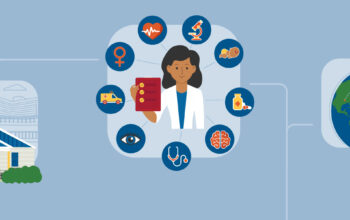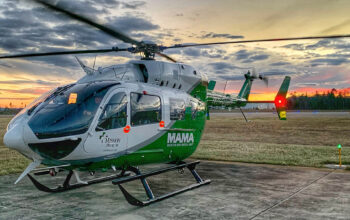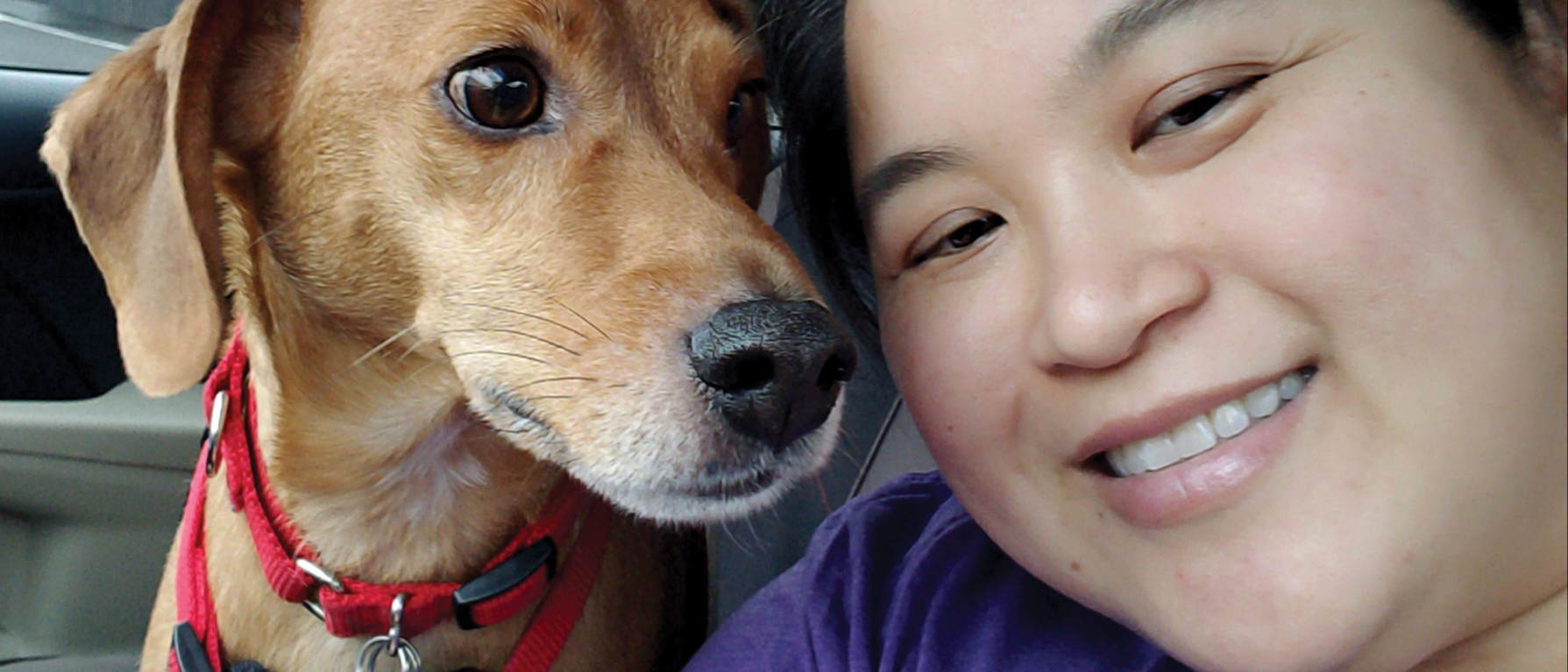Dedication, professionalism and teamwork save lives after tragic shooting.

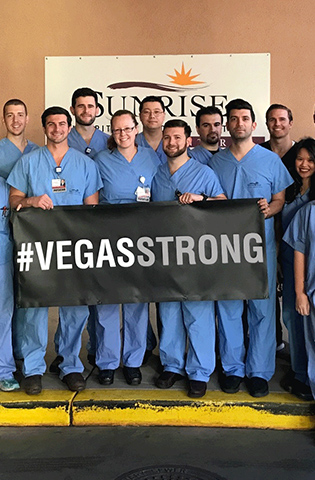
Even though Las Vegas is a bright, busy 24/7 city, Sunday nights are usually fairly calm. At 10 p.m. on Oct. 1, 2017, doctors in the emergency room at Sunrise Hospital & Medical Center were taking care of a steady stream of patients, but the 52-bed unit wasn’t overwhelmed. About six miles away, the Route 91 Harvest Festival was winding up its evening with country music star Jason Aldean onstage.
Then shots rang out from the 32nd floor of the Mandalay Bay hotel overlooking the festival site. Thousands of festivalgoers fled the scene in fear while hundreds more were struck by gunfire.
Among the attendees was Tracy Szymanski, Sunrise’s director of guest services.
“When the shots started going off I felt helpless, because even though I work in healthcare I’m not a clinician,” Szymanski says. “I don’t know CPR, and didn’t know what to do for people. But I did know that they were going to need help, so I called our administrator on duty and told him that if I’d seen 10 people hurt, I’d seen 100 and that the hospital needed to prepare itself. I knew there were going to be a lot of gunshot wounds. I didn’t have any idea that we were going to get more than 200 patients.”
Szymanski’s call was among several that gave the hospital staff some advance notice, which allowed them to begin mobilizing. They would need every second, because within moments ambulances, police cars, trucks and passenger cars full of wounded people would be making their way to Sunrise. Throughout that long night and into the next morning, the Sunrise team – colleagues from every department – worked side by side to save lives. And in the ensuing days and weeks, they stayed strong for patients, families and each other as the healing process began. Here are some of their stories.
Tracy Szymanski
Director, Guest Services and festival attendee
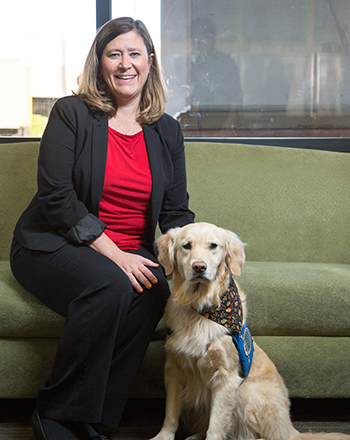
Tracy Szymanski credits comfort dogs with helping her, the Sunrise staff and many patients and families in the hours and days after the shooting.
Immediately after calling the administrator on call at Sunrise, Szymanski made her way to the hospital. In addition to her guest-services position, she also is director of the PBX, or internal communications department, so she set about finding radios that physicians and other emergency-care personnel could use to stay in touch with administrators and others as the night wore on. She also began the process of helping family members and others who came to the facility looking for news.
“I grabbed staff and we reached into our care carts and dug out every cellphone charger we could find,” she says. “People had been at the concert taking pictures and sending texts for hours, so their phones were either low or out of power. I also got busy finding clean clothing, because a lot of those people had carried their friends or loved ones to an ambulance or car and so they were soiled from the wounds. We had to get them out of those clothes.”
After a long night of helping, she was sent home the following morning and, though exhausted, couldn’t sleep as she tried to think of ways to help patients, survivors and her co-workers. When she was back at the hospital, she hit upon an idea.
“I supervise our canine therapy program, and I can tell you they provide a lot of healing,” Szymanski says. “Our dog, Lois, is a member of the Lutheran Church Charities K-9 Comfort Dogs group, and they approached us about coming to the hospital. We have a very strict vetting process to be a volunteer here, and normally I would have had to say no since they hadn’t gone through the background check, drug test, TB test and other steps to be cleared. This time I knew I needed to think outside the box and get them here, so we asked for a reference letter from another facility where they already volunteered showing that they’d been checked, and then gave them a ‘mini application’ and they all complied.”
I would meet them every morning in our conference room, and that was my daily therapy.— Tracy Szymanski, Director of Guest Services and festival attendee

Comfort dogs brought smiles to everyone they met at Sunrise.
From that day through the next two weeks, six or seven dogs spent several hours a day at Sunrise, lifting the spirits of patients, families and staff alike.
“I would meet them every morning in our Rendezvous conference room, and that was my daily therapy,” Szymanski says. “I got to be the first person every day to get a dose of furry friendship. I came in at the end of my shift one day to find one of our associate administrators crawling on the floor and laughing with the dogs. Those dogs helped us start to recover.”
At the same time, she brought in teams of performers from Musicians On Call, who gave mini-concerts for staff and patients. Some of the performers on the Route 91 bill also came by to visit and bond with patients and staff. The healing power of animals and music is a powerful thing, and Szymanski says that was needed in those early days.
“Everyone here was grieving and trying to figure out how to deal with what they saw — no amount of training or drills could prepare anyone for the ER that night. I kept seeing one patient who was elevating his leg against the wall, telling us to take care of the person next to him who had worse injuries. I kept seeing our patient transporters getting people out of truck beds and cars as fast as they could. I kept seeing our environmental services workers cleaning up OR suites in minutes. That’s why we have Lois on a permanent-standby status, so she can come in whenever we need her. It’s funny; I didn’t think I could contribute anything when it was all happening, but I was wrong.”
Dr. Kevin Menes
Emergency Room Physician
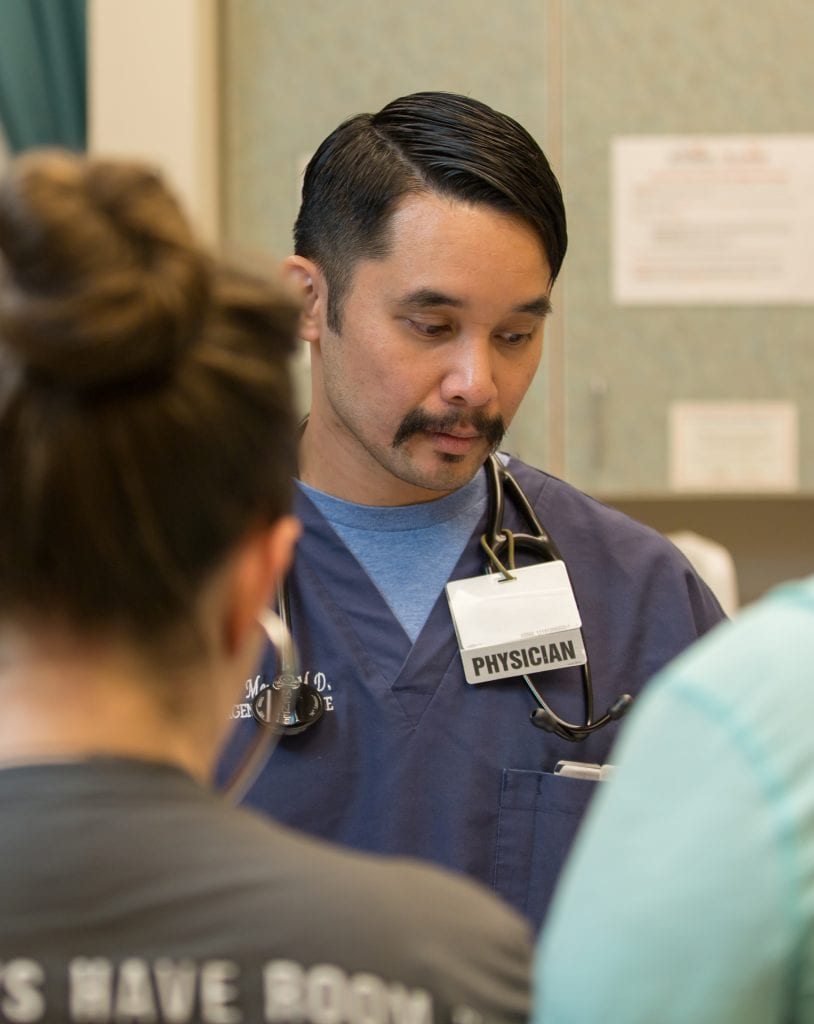
As one of the weekend “night docs,” Dr. Menes works 8 p.m. to 6 a.m. Friday through Sunday. On this evening, the emergency room was a little slow, and he and the three other physicians on duty (Drs. Patrick Flores, James Walker and Michael Tang) were catching up when the call came over for him to report to station one, the emergency room’s main administrative area.
“We listened to the telemetry call come in saying to prepare for a mass casualty,” Dr. Menes recalls. “There was a police officer there for an unrelated incident, and I looked at him. He was listening to his radio as well, and when I asked him if this was real, he nodded yes.”
Dr. Menes is a volunteer medic for the police department’s SWAT team, so he ran to his car and got his own police radio. The words he heard were: automatic gunfire, country music concert, active shooter.
“At that point, I knew we were going to end up with hundreds, if not thousands, of gunshot victims,” he says. “So, we began putting every asset we had into place. I went to the secretaries and said we needed every OR open, we needed every surgeon, anesthesiologist, scrub tech, nurse … we needed everybody in the hospital, and needed them now. They went to work reaching out to every doctor we have, regardless of specialty, and getting them to head to the hospital. Then we began to prepare nurses at every station so they knew what we would need in terms of running IVs, keeping patients from crashing and everything else that goes on with these types of injuries. I rounded up the other doctors in the ER and we divided up the areas where we’d be putting the patients.”
As the senior physician on duty, Dr. Menes was stationed at the front triage area to assess each patient as they were unloaded from ambulances, police cars and other vehicles in Sunrise’s driveway. He had earlier called for gurneys and wheelchairs, as well as people to push them, so that patients could be moved inside as quickly as possible. Within minutes, everything was in place. And the team waited.
“First you could hear sirens in the distance, and they kept getting louder,” he says. “Then the police cruisers came. We are the closest trauma center to the shooting site, and they were running red lights to get to us. Each cruiser had four or five badly injured people, and we got busy grading them by severity of injury so we could get them into the proper area inside. Normally you would use color-coded tags, with red for the most severe injuries, but there was no time that night. I knew that if I sat down and wrote on paper, the paper would get lost and someone could die. So, we set up different areas for triage, depending on where the person was wounded and the wound’s severity, and categorized them that way. I put my trust in the team, that they were going to do a good job on the things that they normally do every single day, just in a huge-volume situation. And they did more than anybody could ever have expected.”
I put my trust in the team, that they were going to do a good job on the things they normally do every single day, just in a huge-volume situation. And they did more than anybody could ever have expected.— Dr. Kevin Menes, Emergency room physician
Vehicles of every type continued to race to the hospital driveway, while doctors and staff offloaded patients and got them inside for triage, treatment and surgery. During the first half hour, everything was handled by the stay on duty when the call came, and soon after additional doctors, nurses and other personnel began to arrive.
“We’d intubate patients, get them on ventilators, just over and over,” Dr. Menes says. “Normally you’d have a nurse, respiratory tech, other team members and a controlled environment. In that first period of time it was just a few doctors and some nurses pushing drugs. We’d work, move that patient to the ICU and then work on the next one.”
In that first hour alone, the Sunrise ER team treated more than 200 patients. All were gunshot wounds.
“It was a sea of patients,” Dr. Menes says. “We kept stabilizing people and handing them off to surgery or the ICU. After everything was done, we treated more than 30 gunshot wounds an hour, we figure. As more doctors arrived, they jumped into our system and augmented us. We got faster and faster, and about seven hours later we’d gotten most of the patients who’d come in either into surgery, or treated and with a plan of what would be next.”
“It is a testament to this hospital and the staff that came down and did a job that night,” he continues. “It might have been pushing a gurney, which allowed a doctor to save a life. Everybody made this happen. These are people who responded to a call late on a Sunday night and got there. This was a tragedy, but what these employees and doctors did was amazing.”
Julie Huizinga
Trauma RN/Sunrise Hospital Emergency Room
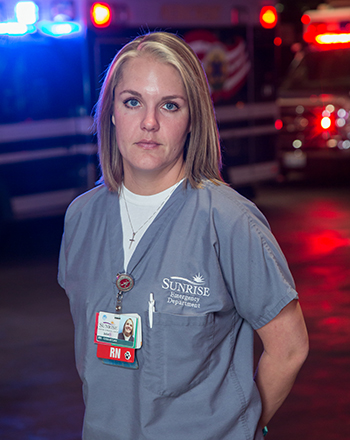
Like many of her hospital colleagues, Julie Huizinga was unwinding that evening when a friend called and told her to turn on the news. She took one look, jumped in her truck and drove to work.
“I think the hardest thing to deal with that night was walking by someone and wanting to help them but you have to help the more severely wounded patient next to them, and try your best to reassure them that you will be there as soon as you can,” she recalls of the scene she found.
“When I first walked into the ER, I couldn’t believe what I was seeing,” Huizinga says. “There were so many patients. There were patients in all trauma bays, most of them intubated or needing intubation. In that moment, all you can do is think of ways to help the patients. Looking back now, I remember how even though it was chaotic, it was organized chaos. All the staff members were working together, so fluidly without even realizing it. As one patient moved out, another one came in and we got to work.”
She can’t say enough about the staff, who she credits with saving lives even as the wounded continued to flood into the ER. “All the staff that were there that night were amazing,” she says. “Environmental services people were there every time we moved someone out to clean the way for another patient. I remember a guy coming around with a cart full of bottled water and passing it out. We all just looked at each other and took one; it was one of the best bottles of water I’ve ever had.”
All you can do is think of ways to help the patients.— Julie Huizinga, Trauma RN/Sunrise Hospital Emergency Room
The patients themselves supported the staff’s efforts, she adds, noting that “They were so respectful of each other. You would go to help someone and they would say ‘No, no, go help him/her. I’m OK.’ No one was putting themselves first. It was like the community of all these strangers at the concert came together and were still looking out for each other.”
Having been through a mass casualty event in her home state of Alabama following a tornado, Huizinga says that the night itself, and the period after, has been hard.
“I honestly try not to think about it,” she says. “Coming into this I had an idea of what it would be like. This was different because this wasn’t Mother Nature doing the damage — it was a person. But I also feel as though it helped us on night shift come together even more. There isn’t a shift that goes by when they announce an ambulance that two or three other nurses aren’t in there helping the primary nurse. I’ve always worked nights for my 11 years as a nurse. This crew we have at Sunrise is honestly the best I’ve seen.”
Marcus Thomas
Lead Supervisor, Environmental Services
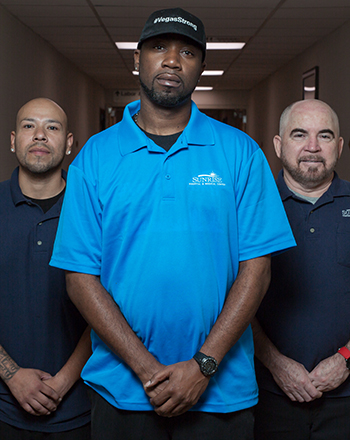
When the status-board operator called Marcus Thomas and told him he was needed in the emergency room, he knew something major was happening. That’s why he stopped and collected his team on the way, which turned out to be hugely beneficial in those frantic early moments when patients began to arrive from the concert venue.
“I saw a lot of ambulances and trucks pulling up and letting people out who’d obviously been shot,” Thomas says. “And my phone was going crazy with calls and texts from people saying there’d been a shooting on The Strip. I turned to my team who’d just come in for the night shift, and also the people from the swing shift who’d come down, and asked all of them to stay as long as we would need them. Then I asked everyone to go and find beds, gurneys, wheelchairs, whatever they could, and get those to the ER and line them up outside.”
Thomas has taken part in many drills because Sunrise’s ER is one of HCA Healthcare’s largest and sees high volumes throughout the year. He has seen nurses, doctors, administrative personnel and everyone else work like a team in those situations, but nothing compared to what unfolded this particular night.
We worked alone, we worked in pairs and we worked in teams to make sure the doctors and nurses had everything they needed.— Marcus Thomas, Lead Supervisor, Environmental Services
“We handled it,” Thomas says. “Nobody panicked. We all did what we had to do, and the main focus never got away from helping every one of those people who came in. I had five ladies on my crew who went into those ORs every time a surgery ended and cleaned them. They turned those OR suites in five minutes, and usually it takes a lot longer. We got it done — there was no other choice.”
At the same time, the environmental services employees were deployed across the rest of Sunrise, cleaning rooms that were being vacated by patients who could be discharged, in order to make room for the dozens of victims who were in surgery or who needed to be admitted. Eventually 167 patients were discharged by the early morning hours.
“I was in constant contact with our managers and supervisors, and they helped us stay calm and get it done,” Thomas says. “We were full to capacity, and they were still bringing people in. We were even cleaning outside, because a lot of treatment began out there and so there was a need. We worked alone, we worked in pairs and we worked in teams to make sure the doctors and nurses had everything they needed.”
Kimberly Hatchel
Chief Nursing Officer
Coming home from vacation, it’s natural to start thinking about getting back to work, and what might be waiting on your desk or in your inbox. For Kimberly Hatchel, work came to her 800 miles from home, as she was in the car with her family traveling back from a short vacation in Nebraska.
“I got a message from Alan Keesee, my COO, who was the first administrator on the ground because he was on call,” Hatchel says. “We are a busy trauma center, and so we get activated for situations on a regular basis. His text read ‘come to hospital now; it is a war.’ That’s when I knew that this was severe.”
Hatchel got phones from her family members in the car, and soon had a remote command center of her own set up with three smartphones and a tablet. She began interfacing with every ICU at Sunrise, along with other departments and the CNOs at sister HCA Healthcare facilities MountainView Hospital and Southern Hills Hospital & Medical Center.
For the next several hours, she tracked requests and prioritized staff mobilization as she raced back toward Las Vegas.
“I was communicating what each group needed to others,” she says. “I had charge nurses and team leaders texting me. Had I been at Sunrise I would have been in the command center, and I would not have had three phones at my disposal. Although this was an unusual setup, I was able to get them all connected to what they needed whether that was chest tubes, central line kits, intracranial pressure monitors or blood, to keep those people alive.”
Hatchel utilized the iMobile system to mass-message caregivers over its secure instant-messaging system, which she says saved precious minutes by getting information out to everyone at once.
I got a message from my COO…his text read ‘come to hospital now; it is a war.’ That’s when I knew this was severe.— Kimberly Hatchel, Chief Nursing Officer
“We were one of the first larger hospitals to go live on iMobile, and it really proved its value,” she says. “There’s no way we could have communicated with the whole house that quickly otherwise, and within two minutes there was lots of help headed to the ER. We never anticipated using it that way, but it’s great to know that we have that kind of asset.”
The iMobile system also was able to keep hospital staff in touch with each other after cellphone coverage ceased in parts of the building due to the massive number of people onsite trying to call in or out. And because she wasn’t onsite, staff could also reach Hatchel.
“Had I been there, they might not have been able to contact me,” she says. “But out where I was, they could get me and then I could relay information and messages on. It’s amazing how things work out the way they are supposed to, even in such a horrible situation.”

Cards and letters of appreciation have poured into Sunrise since the event.
Sunrise Hospital & Medical Center
200+ patients treated
Southern Hills Hospital & Medical Center
12 patients treated
MountainView Hospital
8 patients treated
Christian Pangan
Lab Assistant/Phlebotomist
Calls to come to the emergency room are nothing new for Sunrise’s phlebotomy team, and when an alert came through Christian Pangan didn’t think much of it. En route, however, he fell into step with coworkers who’d already heard that something major was happening.
“We thought maybe it was several gunshot wounds, which has happened before and requires a few more people,” Pangan says. “Then we got to the ER, saw all those people coming in and heard screaming from outside. They were coming in the doors, and up the driveway, in group after group.”
Another veteran of many drills, Pangan says those are helpful in that they prepare everyone for what needs to be done in a mass-casualty situation. But the reality is still very different.
“Nothing gets you ready for this,” he says. “For instance, with that many people we can’t possibly draw blood because they’re not being registered and admitted as they normally would be. So, I realized I would be better off going out front to help get patients onto gurneys and into triage. My team did just that, and for the first 30 minutes we were taking people out of cars and trucks, getting them to the doctors for assessment and then putting them into the proper area for additional treatment.”
Pangan also realized that field assessments at the concert site needed to be re-evaluated. In one instance, he met a truck transporting two victims, with the initial indication being that they had died from their wounds. Realizing that the people who brought them, fellow concertgoers themselves, were probably in shock, he wanted to make certain.
For the first 30 minutes my team was taking people out of cars and trucks, getting them to the doctors for assessment and then putting them into the proper area for additional treatment.— Christian Pangan, Lab Assistant/Phlebotemist
“They told me that these two ladies were mother and daughter, and I couldn’t find a pulse for the mother,” Pangan says. “I saw the daughter’s eyes move, and there was a pulse there. I got her on a gurney and jumped on top so I could do CPR. Once we got her into the ER and someone else could take over, I ran to the next car.”
Soon after, he came across a patient who was holding gauze on her shoulder, but who had a neck wound rather than a shoulder wound and needed immediate assistance. He got her moved to the proper treatment area, and then lost sight of her. Like the young lady in the truck, he doesn’t know her final outcome.
“I hope they’re both OK,” Pangan says. “It bothers me not to know, but I do know that we saved so many people that night. But everybody did their part and more. We helped the doctors, we helped the nurses, we jumped in wherever we had to. And the next day, we were back for our regular shift.”
Todd Sklamberg
Chief Executive Officer
Like the rest of his staff, Todd Sklamberg got a notification on his phone via Sunrise’s trauma-paging system a little after 10 p.m. It said that the Las Vegas Fire Department was reporting a mass casualty of some kind, but had no further information. He called the hospital to make sure the house supervisor was aware of the issue, because these calls come in regularly, such as after a multi-car accident.
“We have the resources ready at all times to handle something like that, which might involve a few people,” Sklamberg says. “But I still thought I should come in, and even as I was getting ready to leave home I saw through the system a repeating message that said, ‘gunshot victim trauma 1,’ and I realized this was out of the ordinary, even for a large event.”
Arriving at the emergency room doors, he realized that this was unprecedented not just for Sunrise, but for Las Vegas. ER bays, trauma areas, hallways, Sunrise Children’s ER, all lined with patients either waiting for help, or being prepared for treatment or surgery.
Within a half hour we had more than 100 doctors in this hospital; more than three dozen surgeons from neurology to cardiology to general to plastic; even four pediatric surgeons came in.— Todd Sklamberg, Chief Executive Officer
“They were arriving four or five at a time, in trucks, ambulances, police cars … any way people could get the wounded to us,” Sklamberg says. “It was a constant stream. I positioned myself, along with our COO and house supervisors, in the middle of the trauma bay. We called in additional personnel to activate our command center, and we did what we could to help the teams in the ER. These patients had gunshot wounds in the chest, head and belly, even multiple wounds, and to see our team perform the way they did was nothing short of remarkable. You can’t drill for this. We had phlebotomists doing CPR; we had respiratory therapists making packs of chest tubes and intubation kits.”
And then there were the doctors. “Within a half hour we had more than 100 doctors in this hospital, more than three dozen surgeons from neurology to cardiology to general to plastic; even four pediatric surgeons came in,” Sklamberg says, adding that 40 anesthesiologists also came in to help.
As the command center was set up and the patients were seen to, Sklamberg and other administrators turned the hospital auditorium into a family service center.
“We set that up as a receiving and waiting room, and soon we had 200 family members in there,” Sklamberg says. “A big challenge was that 92 of the 212 patients we were treating had no form of identification on them, and so in addition to providing updates, we also had teams of managers, directors and supervisors meeting with families to obtain identifying marks and characteristics of their loved one, be it piercings, body art or scars, along with pictures, so we could match up patients with those names.”
Treating more than 200 people in about an hour, many of whom were severely wounded, took the kind of teamwork that a hospital administrator can only dream of. Sklamberg says he’s not surprised that the Sunrise staff rose to the challenge, and expresses how humbled he was by the sheer magnitude of their efforts.
“It really was a war zone in there, and it was all hands on deck. Everyone did their job, and did other people’s jobs as well. We turned the entire ER three or four times during this event, and turned the OR suites multiple times as well. At one point, we had 10 OR suites in use. We never went on diversion, but took in every patient who came to our doors. We were innovative. We had teams mobilizing crash carts and they made 50 of them. We had people making sure supplies never dwindled, and calling back to the pharmacy to make sure that any drugs needed would be there. This is an ER that sees more than 100,000 people annually, so the staff knows what to do. But people didn’t just meet needs, they anticipated them.”
During the hours after the shooting, the hospital staff was focused on what was happening within its four walls. Outside, however, the Las Vegas community, the nation and the world were watching them with awe and admiration. Even as patients were being triaged and treated, area residents began flooding the hospital with thoughts, prayers — and food. Dozens of pizzas alone ensured that waiting families and friends, as well as care teams, could have something to eat when they could take a short break. “We had completed emergency drills only a couple of days before. You can drill on a regular basis, but nothing could have prepared us for the magnitude of Oct. 1,” Sklamberg says. “I’ve never been so proud of our hospital, and our city, to see how we collectively responded to this unprecedented event.”
These are just a few of our HCA Healthcare team members’ amazing stories of skill, compassion and courage in the face of crisis. We encourage you to share your story using the hashtag #StandTogetherVegas
